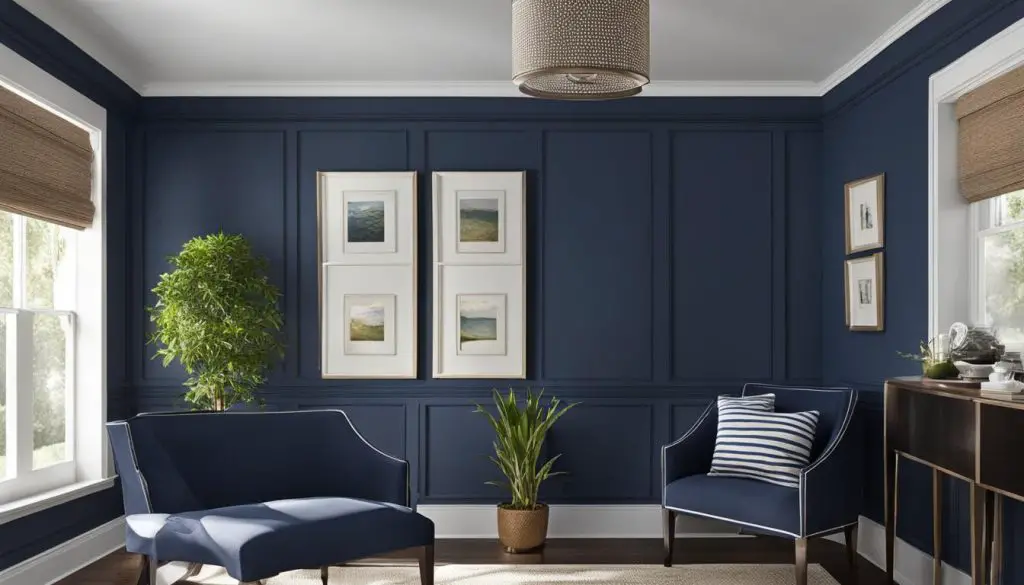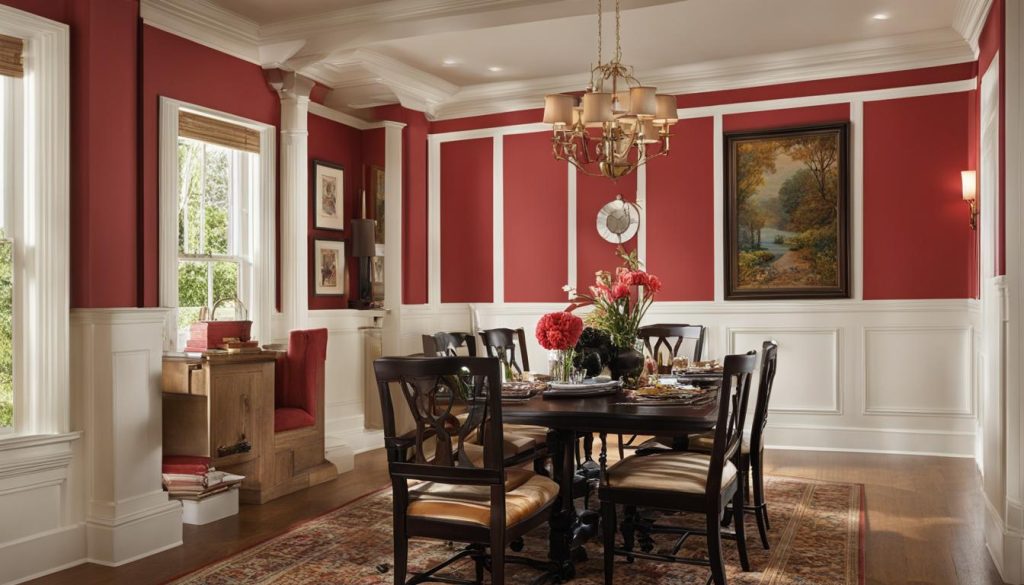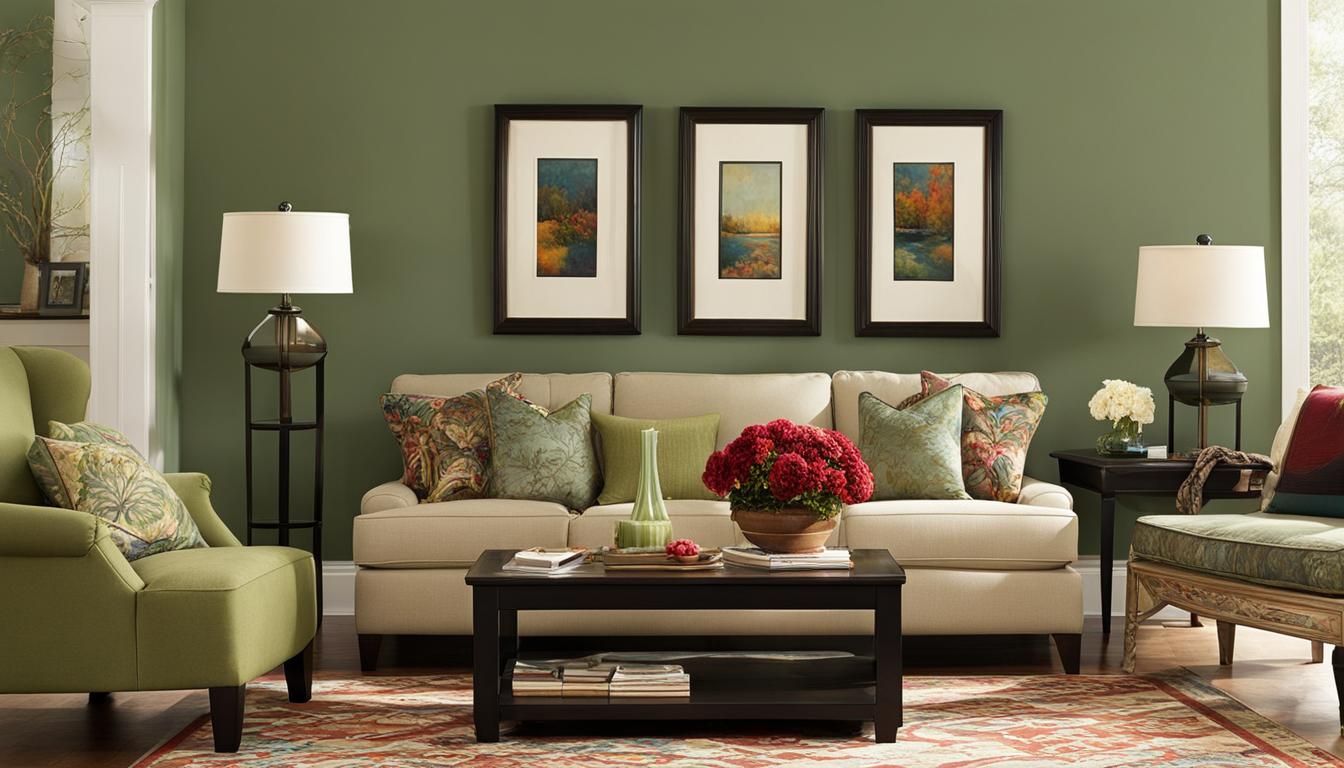Looking to update and modernize your space? One simple way to transform your home is by using chair rails as a design element. In this guide, I will provide you with paint ideas and inspiration to make the most of your chair rail.
Whether you have an older home with decorative moldings or a newer home with a chair rail, there are plenty of options to consider. From two-tone palettes to single-color approaches, the possibilities are endless. Let’s dive into some paint ideas and techniques that will help you create a stylish and visually appealing space.
Key Takeaways:
- Consider the age of your home when choosing a paint color palette for your chair rail.
- Older homes can pull off a two-color palette, while newer homes can benefit from using one color on both the upper and lower walls.
- Enhance your chair rail by adding additional moldings and painting them in the same color and sheen as the existing trim.
- When choosing colors, take into account factors such as room dimensions, lighting, and existing furniture and decor.
- Popular dining room color schemes include monochromatic and analogous color schemes.
Painting an Old Home with Chair Rails (1960s & earlier)
Older homes, particularly those from the 1960s and earlier, can pull off a two-color or two-tone palette more easily than newer homes. This is because older homes often have other decorative moldings that can be set off with paint, and a two-color palette was often used when the home was originally built. The darker color usually goes on the lower wall, and the lighter color on the upper wall. It is more common to have white or a soft off-white as one of the colors. Some homes can also pair a darker color on the lower or upper walls with a coordinating wallpaper as its partner.
A two-color palette in an older home with chair rails allows for a play of depth and dimension, highlighting the architectural details of the room. By selecting a darker color for the lower wall, it visually anchors the space and adds a sense of coziness. The lighter color on the upper wall creates an illusion of height, making the room feel more spacious. This classic color combination creates a timeless and elegant look, particularly suited to traditional or vintage-inspired homes.
When choosing colors for an older home with chair rails, it’s important to consider the existing aesthetic and architectural features of the space. Opting for soft neutrals, warm earth tones, or muted pastels can enhance the vintage charm of the home. However, if you’re looking to add a contemporary touch, you can also experiment with bolder color choices that complement the overall design scheme. The key is to strike a balance between preserving the home’s character and injecting your personal style.
Table: Color Palette Ideas for Painting an Old Home with Chair Rails
| Color Palette | Description |
|---|---|
| Classic Neutrals | Soft whites, creams, and beiges create a timeless and sophisticated look. |
| Earthy Hues | Warm browns, taupes, and muted greens bring a cozy and natural feel to the space. |
| Soft Pastels | Pale pinks, blues, and yellows add a touch of whimsy and femininity. |
| Traditional Jewel Tones | Deep blues, greens, and reds evoke a sense of opulence and grandeur. |
| Contemporary Accents | Subtle pops of bold colors like teal, navy, or mustard can modernize the space while still respecting its vintage charm. |
Updating a 1970s or Newer Room with Wood Chair Rail
When it comes to updating a 1970s or newer room with wood chair rail, the key is to create a more modern and updated look. One approach is to use a one-color palette for both the upper and lower walls. This gives the room a cohesive and streamlined appearance, suitable for homes built after the 1960s or 1990s. However, it’s important to note that there are always exceptions, and some homes may still suit a two-color palette depending on personal style and target market.
By opting for a one-color palette, you can create a clean and contemporary aesthetic. This approach is especially popular for homeowners looking to update and modernize their space. It simplifies the room and creates a visually appealing backdrop for furniture and decor. It’s important to choose a color that complements the wood chair rail and other elements of the room.
While a one-color palette is a popular choice for updating a 1970s or newer room with wood chair rail, it’s essential to consider the overall style and architecture of the home. Some homeowners may prefer a two-color palette for a more traditional and elegant look. It’s all about finding the right balance between modernity and classic design elements. Ultimately, the choice between a one-color or two-color palette depends on personal preference and the desired aesthetic.
Updating a 1970s or Newer Room with Wood Chair Rail: Pros and Cons
When updating a 1970s or newer room with wood chair rail, there are several pros and cons to consider:
- Pros:
- A one-color palette creates a modern and streamlined look.
- The simplicity of a one-color palette allows furniture and decor to take center stage.
- This approach is suitable for homes built after the 1960s or 1990s.
- Cons:
- Some homeowners may prefer the traditional look of a two-color palette.
- A one-color palette may not suit all home styles and architectural designs.
- Personal preference plays a significant role in the decision-making process.
Ultimately, updating a 1970s or newer room with wood chair rail is a personal choice that should reflect your individual style and taste. Whether you opt for a one-color or two-color palette, the goal is to create a space that feels updated and visually appealing.
| Pros | Cons |
|---|---|
| A one-color palette creates a modern and streamlined look. | Some homeowners may prefer the traditional look of a two-color palette. |
| The simplicity of a one-color palette allows furniture and decor to take center stage. | A one-color palette may not suit all home styles and architectural designs. |
| This approach is suitable for homes built after the 1960s or 1990s. | Personal preference plays a significant role in the decision-making process. |
A Newer Style Home with a Traditional Vibe
If you have a newer home with a chair rail but prefer a more traditional style, you can consider a two-tone or two-color palette. This approach gives a polite nod towards the traditional end of things and can work well with wood crown molding, baseboards, and chair rail. It’s important to note that choosing a two-color palette is not updating the home but rather embracing a specific style. For resale purposes, it may be more favorable to stick to one paint color.
When opting for a two-tone palette in a newer home with a traditional vibe, there are a few things to keep in mind. First, consider the color contrast between the upper and lower walls. You want the colors to complement each other and create a harmonious look. For example, you could pair a warm, neutral color on the upper walls with a deeper, richer color on the lower walls.
Another consideration is the overall color scheme of the room. The two-color palette should fit in with the existing furnishings and décor to create a cohesive and inviting space. Take into account the style of furniture, the color of curtains or blinds, and any other decorative elements in the room. You want the chair rail and the chosen colors to enhance the traditional aesthetic and create a sense of warmth and comfort.
Remember, a two-tone palette is not the only option for a newer home with a traditional vibe. Depending on your personal taste and style, you may also consider other approaches, such as a single-color palette, that can still achieve the desired traditional look. Ultimately, the goal is to create a space that reflects your personal style while maintaining a cohesive and inviting atmosphere.
Table: Two-Tone Palette Ideas for a Newer Home with a Traditional Vibe
| Upper Wall Color | Lower Wall Color |
|---|---|
| Light Gray | Navy Blue |
| Beige | Burgundy |
| Soft Blue | Deep Green |
What Color Should the Chair Rail be Painted?
When it comes to painting the chair rail, the general recommendation is to paint it the same color as the rest of the trim in the room. This helps create a cohesive look and ensures that the chair rail blends in with the overall trim work. Whether the trim is white, off-white, or another color, painting the chair rail with a satin finish in the same shade helps it seamlessly blend with the other elements in the room.
By painting the chair rail the same color as the rest of the trim, you create a unified and polished appearance. This approach is particularly effective in rooms where the chair rail is meant to be a subtle accent rather than a standout feature. It allows the chair rail to maintain its architectural presence while seamlessly integrating with the surrounding elements.
“Painting the chair rail the same color as the walls creates a cohesive and harmonious look in the room.”
Painting the chair rail with the same color as the walls can also be a suitable option in certain cases. This approach works well when you want the chair rail to blend in with the wall color and create a sense of continuity. It is especially effective when using a light or neutral color palette throughout the room.
In conclusion, painting the chair rail the same color as the rest of the trim is generally recommended to achieve a cohesive look in the room. However, painting it the same color as the walls can also be a viable option for those seeking a seamless and harmonious appearance. Consider the overall style and desired effect of the room when making a decision on how to paint the chair rail.
An Easy Chair Rail Update Idea
Enhancing a room with chair rails is a simple and effective way to add architectural interest and visual appeal. One easy chair rail update idea is to incorporate additional moldings on the lower walls and paint them in the same color and sheen as the existing chair rail and trim. This technique, known as enhancement, can transform the chair rail into a modern and coveted application that seamlessly blends with the overall design of the room.
Enhancement works well for both old and new homes, offering a fresh and updated look. By adding these extra moldings, the chair rail becomes more than just a decorative element; it becomes a focal point that elevates the entire space. Whether you have a traditional or contemporary style, enhancement provides an opportunity to personalize your room and create a unique ambiance.
To achieve the best results with this chair rail update idea, it’s important to choose moldings that complement the existing chair rail and trim. The paint color should match the chair rail and trim as well, creating a cohesive and harmonious look. The enhanced chair rail will not only enhance the overall aesthetics of the room but also showcase your attention to detail and design sensibilities.

Enhancement for Chair Rail: Step-by-Step Guide
- Measure and mark the desired height for the additional moldings on the lower walls.
- Select the type and design of the moldings that align with your aesthetic preferences.
- Cut the moldings to the appropriate length and angle to fit the walls.
- Secure the moldings to the walls using adhesive or nails.
- Fill any gaps or nail holes with wood putty and sand them smooth.
- Prime and paint the moldings in the same color and sheen as the existing chair rail and trim.
- Apply a final coat of paint to ensure a seamless and professional finish.
With these simple steps, you can easily enhance your chair rail and create a stunning focal point in your room. Whether you choose to enhance an old home or modernize a newer space, this chair rail update idea is sure to elevate the aesthetic appeal and make a lasting impression.
Should You Remove Your Chair Rail or Enhance It?
Deciding whether to remove or enhance your chair rail depends on various factors. Consider your skill level in adding additional moldings and the potential for a ledge to be left around the room if the chair rail is removed. If you’re not confident in your abilities to remove the chair rail, enhancing it can be a great option. Converting the chair rail into wainscoting, beadboard, or board and batten can give your space a fresh look while still embracing the chair rail.
Enhancing the chair rail allows you to update and modernize your space without completely removing it. By adding additional moldings to the lower walls and painting them in the same color and sheen as the existing chair rail and trim, you can create a cohesive and stylish look. This technique, known as enhancement, can work for both old and new homes, and it allows the chair rail to become a modern and coveted application that works with the overall design of the room.
There are alternatives to removing or enhancing the chair rail. Some homeowners choose to leave the chair rail as is and simply paint it the same color as the walls or trim to create a unified look. This can be a simple and cost-effective way to update the space without making major changes. Ultimately, the decision to remove or enhance your chair rail depends on your personal preference, skill level, and the desired aesthetic for your home.

Some Chair Rail Update Inspirations
When it comes to updating a space with a chair rail, there are plenty of creative ideas to consider. Whether you want to add visual interest, enhance the traditional vibe, or create a unique look, there are various options to explore. Here are a few chair rail update inspirations to get you started:
1. Chair Rail Wainscoting
One popular way to update a chair rail is by incorporating wainscoting. Wainscoting is a type of paneling that is typically installed on the lower portion of the wall below the chair rail. It adds texture, depth, and a touch of elegance to the room. You can choose from different styles of wainscoting such as raised panel, beadboard, or shaker panel to match your desired aesthetic.
2. Chair Rail Wallpaper Combinations
Another creative option is to pair your chair rail with wallpaper. Wallpaper can be applied either above or below the chair rail to create a striking visual effect. You can choose bold patterns, intricate designs, or subtle textures to complement the chair rail and add personality to the space. Consider using complementary colors or contrasting patterns to make a statement and create a visually captivating look.
3. Additional Molding Details
If you want to take your chair rail update to the next level, consider adding additional molding details to the lower walls. By incorporating crown molding, baseboards, and other decorative moldings, you can create a more intricate and sophisticated look. Make sure to paint the additional moldings in the same color and sheen as the chair rail and trim for a cohesive and polished appearance.
These chair rail update inspirations offer just a glimpse of the many possibilities available. The key is to find a style that suits your personal taste and complements the overall design of your space. Whether you choose wainscoting, wallpaper combinations, or additional molding details, updating your chair rail can transform your room into a visually stunning and inviting space.
Color Me Impressed: Factors to Consider When Choosing Colors
When it comes to choosing colors for a dining room with a chair rail, there are several factors to take into consideration. The dimensions of the room play a crucial role in determining the color scheme. In a small dining room, lighter shades can create an illusion of spaciousness, while darker hues can bring a cozy ambiance to a larger space. It’s important to assess the natural lighting conditions in the room as well. Rooms with ample natural light can accommodate both light and dark colors, while rooms with limited natural light may benefit from lighter shades to brighten up the space.
The existing furniture and decor in the dining room should also be considered when selecting colors. Take into account the colors and styles of the dining table, chairs, curtains, and other furnishings. Choosing colors that coordinate or complement the existing elements can create a cohesive and visually pleasing design. Additionally, personal preferences should not be overlooked. Consider the mood and atmosphere you want to create in the dining room. Do you prefer vibrant and energetic colors, or more calming and neutral tones? Your personal taste should guide your color selection process.
“The dimensions of the room, lighting conditions, existing furniture and decor, and personal preferences all play a role in selecting the right colors.”
To summarize, when choosing colors for a dining room with a chair rail, consider the dimensions of the room, lighting conditions, existing furniture and decor, and personal preferences. Lighter shades can make smaller rooms feel more spacious, while darker hues can create a cozy ambiance in larger spaces. Coordinating colors with the existing furniture and decor helps achieve a cohesive design. Ultimately, the color scheme should reflect your personal style and create the desired atmosphere in the dining room.
Factors to Consider When Choosing Colors:
- Room dimensions
- Lighting conditions
- Existing furniture and decor
- Personal preferences
A Colorful Feast: Popular Dining Room Color Schemes
When it comes to selecting the right color scheme for your dining room, there are plenty of popular options to choose from. The right color scheme can set the mood, create a welcoming atmosphere, and enhance the overall aesthetic of the space. In this section, I’ll explore some classic color combinations that are commonly used in dining rooms.
Classic Color Combinations
One classic color combination for dining rooms is the monochromatic scheme. This approach involves using various shades of a single color throughout the room. For example, you could choose different shades of blue, ranging from deep navy to light sky blue, to create a cohesive and sophisticated look. Monochromatic color schemes are timeless and can work well in both traditional and modern dining rooms.
Another popular option is the analogous color scheme, which involves using colors that are adjacent to each other on the color wheel. This creates a harmonious and balanced look in the dining room. For example, you could pair shades of blue and green together, or shades of orange and yellow. Analogous color schemes add visual interest and can create a warm and inviting atmosphere.
Creating Your Perfect Color Scheme
When choosing a color scheme for your dining room, consider factors such as the size of the space, the amount of natural light, and your personal preferences. Darker colors can make a large dining room feel cozy and intimate, while lighter hues can make a small space appear larger and more spacious. Additionally, consider the existing furniture and decor in the room and choose colors that complement and enhance the overall aesthetic.
Remember, there are no hard and fast rules when it comes to color schemes. It’s all about finding the combination that speaks to your personal style and creates the ambiance you desire in your dining room.
Conclusion
Transforming your space with chair rails can be a great way to enhance the overall look and feel of your home. Whether you have an older home or a newer one, there are numerous paint ideas to consider when working with chair rails. From two-tone palettes to single-color approaches, the key is to find a style that suits your home’s architecture and reflects your personal taste.
When choosing paint colors for chair rails, take into account factors like room dimensions, lighting, and existing decor. Darker hues can create a cozy atmosphere in large rooms, while lighter shades can make small rooms feel more spacious. It’s important to choose colors that complement the overall style of the room and evoke the desired emotions.
With chair rails, the possibilities for design and creativity are endless. Explore different paint color ideas, experiment with molding designs, and consider unique techniques like enhancement to add a modern touch. By carefully selecting colors and incorporating chair rails into your space, you can create a dining room that is visually appealing and a true reflection of your personal style.
FAQ
What should I consider when choosing paint colors for a room with a chair rail?
Factors to consider include the age of your home, personal style, room size and shape, lighting conditions, existing furniture and decor, and desired emotions.
Can older homes pull off a two-color palette with a chair rail?
Yes, older homes, particularly those from the 1960s and earlier, can easily pull off a two-color or two-tone palette. The darker color is typically used on the lower wall, while the lighter color is used on the upper wall.
What should I do if I have a newer home with a chair rail?
For a 1970s or newer room with a wood chair rail, it is usually best to use one paint color on both the upper and lower walls for a more updated look. However, some newer homes may still suit a two-color palette depending on personal style and target market.
Should I paint the chair rail the same color as the rest of the trim?
Yes, it is generally recommended to paint the chair rail the same color as the rest of the trim, regardless of its color. This helps create a cohesive look.
How can I enhance a room with a chair rail?
One option is to add additional moldings to the lower walls and paint them in the same color and sheen as the existing chair rail and trim. This technique, called enhancement, can give the chair rail a modern, cohesive look.
Should I remove or enhance my chair rail?
Deciding whether to remove or enhance your chair rail depends on factors such as your skill level in adding additional moldings and the potential for a ledge to be left around the room if the chair rail is removed. Enhancing the chair rail can be a great option, especially if you’re not confident in your abilities to remove it.
Are there any creative ways to update a space with a chair rail?
Yes, some popular options include pairing the chair rail with wallpaper, beadboard, plaid wallpaper, or bold colors. The key is to find a style that suits your home’s architecture and your personal taste.
What color schemes work well for a dining room with a chair rail?
Classic color combinations like monochromatic (shades of a single color) and analogous (colors adjacent on the color wheel) can create a harmonious and elegant atmosphere. The choice of color scheme depends on factors such as the size and shape of the room, lighting conditions, existing furniture and decor, and personal preferences.


